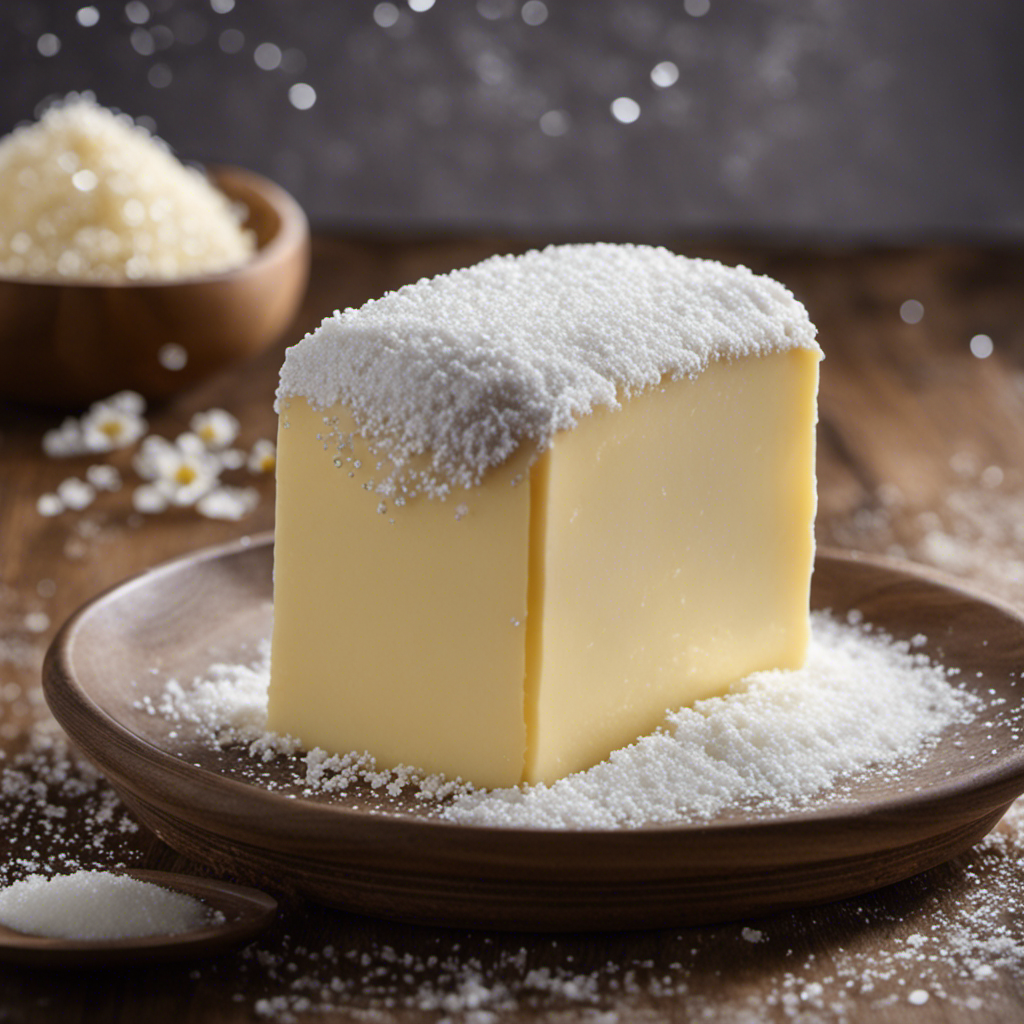I’ve often pondered the duration for which butter remains usable beyond its expiry date. Can consuming it several days or possibly weeks after the specified date still be considered safe?
In this article, we’ll delve into the science behind expiration dates and explore the factors that affect butter freshness. I’ll also share some signs to look out for when determining if butter has gone bad. Plus, I’ll reveal safe practices and tips to extend the life of expired butter.
Let’s uncover the truth and make informed choices about our butter consumption.
Key Takeaways
- Expiration dates on butter are not always accurate indicators of spoilage
- Proper storage techniques play a crucial role in extending shelf life
- Butter is generally safe to consume for a short period of time after the expiration date, but it’s important to use senses to assess its quality
- Freezing surplus expired butter can help extend its shelf life and prevent wastage
The Science Behind Expiration Dates
You might be wondering, ‘What is the science behind expiration dates?’
Well, expiration dates are more than just numbers printed on food packaging. They serve as guidelines for consumers to determine the freshness and safety of a product. However, it’s important to understand that these dates have limitations.
While they provide a general timeframe for when a product is at its best quality, they do not necessarily indicate when it becomes unsafe to consume. The expiration date is based on scientific research that takes into account factors such as microbial growth, chemical reactions, and changes in texture and flavor.
These dates are determined through rigorous testing and analysis to ensure consumer safety. It’s crucial to use your judgment and rely on your senses to assess whether a product is still good to consume, even after its expiration date has passed.
Understanding Butter Shelf Life
When it comes to safe consumption after expiration and proper storage techniques for butter, there are a few key points to keep in mind.
First, it’s important to understand that expiration dates on butter are not always an accurate indicator of spoilage. In many cases, butter can still be safe to consume even after the expiration date, as long as it has been stored properly.
Second, proper storage techniques play a crucial role in extending the shelf life of butter. Keeping it in a cool, dark place and tightly sealed can help prevent it from going rancid or developing off flavors.
Lastly, it’s always a good idea to use your senses to determine if butter is still safe to eat. If it smells off, has an unusual texture, or tastes rancid, it’s best to discard it.
Safe Consumption After Expiration
If butter has exceeded its expiration date, it is generally safe to consume for a short period of time. While it’s always best to follow the recommended guidelines for food safety, there are a few factors to consider when deciding whether to use butter past its expiration date:
-
Smell: If the butter smells rancid or off, it’s best to discard it. A foul odor is a sign that the butter has gone bad.
-
Appearance: If the butter has developed mold or unusual discoloration, it’s not safe to consume. Mold can produce toxins that can make you sick.
-
Taste: If the butter tastes sour or unpleasant, it’s an indication that it has spoiled and should not be consumed.
Proper Storage Techniques
Properly storing butter can help extend its freshness and prevent it from spoiling quickly. One effective method is freezing butter, which can significantly prolong its shelf life. Freezing butter slows down the oxidation process, preventing rancidity and maintaining its quality for a longer time. When freezing butter, it is important to wrap it tightly in an airtight container or freezer bag to prevent freezer burn. To thaw frozen butter, simply transfer it to the refrigerator and allow it to thaw gradually. Avoid microwaving or using hot water to thaw butter, as this can result in a loss of quality. By following these storage techniques, you can enjoy fresh and delicious butter for an extended period of time.
| Storage Technique | Benefits |
|---|---|
| Freezing | Prevents rancidity and extends shelf life |
| Airtight container or freezer bag | Prevents freezer burn |
| Gradual thawing in the refrigerator | Maintains quality |
Factors Affecting Butter Freshness
When it comes to the freshness of butter, there are several factors that play a crucial role.
One of these factors is the storage conditions, as the way butter is stored can greatly impact its quality and shelf life.
Additionally, exploring alternative preservation methods and understanding butter quality indicators can also help in maintaining the freshness and taste of butter for a longer period of time.
Storage Conditions Impact
The storage conditions greatly affect how long you can use butter after the expiration date. Here are three key factors to consider:
-
Proper temperature: Butter should be stored at a cool temperature, ideally between 32-40°F (0-4°C). Higher temperatures can cause the butter to spoil more quickly, while lower temperatures can affect its texture and flavor.
-
Packaging materials: Butter should be kept in its original packaging or wrapped tightly in foil or wax paper to protect it from absorbing odors and flavors from other foods in the fridge. This will help maintain its freshness for a longer period.
-
Air exposure: Butter should be stored in an airtight container to prevent oxidation and the development of off-flavors. Exposure to air can also lead to the growth of bacteria and mold, reducing its shelf life.
Alternative Preservation Methods
To extend the shelf life of butter, consider trying alternative preservation methods.
While refrigeration is the most common way to store butter, there are other techniques you can use to keep it fresh for longer.
One alternative method is to freeze butter. Simply wrap it tightly in plastic wrap or put it in an airtight container before placing it in the freezer. Frozen butter can last up to six months.
Another option is to make homemade ghee, a form of clarified butter. Ghee has a longer shelf life than regular butter and can be used in cooking and baking. To make ghee, melt butter in a saucepan and simmer until the milk solids separate from the golden liquid. Strain the liquid and store it in a jar.
These alternative preservation techniques can help you make the most of your butter and avoid unnecessary waste.
Butter Quality Indicators?
When it comes to butter quality, two important indicators are taste and texture.
The taste of butter should be rich and creamy, with a pleasant, slightly salty flavor. If the butter tastes off or has a rancid flavor, it is a clear sign that it has gone bad and should not be consumed.
Additionally, the texture of butter should be smooth and spreadable. If the butter becomes hard, crumbly, or develops a grainy texture, it is likely past its prime.
To ensure the best quality, it is important to store butter properly and use it within its recommended shelf life.
Signs of Spoiled Butter
If you notice a rancid smell or a sour taste, it’s time to toss that butter. Rancid butter is caused by oxidation, which occurs when the fat molecules in the butter break down and release unpleasant odors and flavors.
One of the key indicators of spoiled butter is a change in color. Fresh butter has a yellow or pale yellow color, but as it goes bad, it can develop a grayish or brownish tint. This change in color is a result of the oxidation process and is a clear sign that the butter is no longer good to use.
It’s important to pay attention to these visual cues and trust your senses when determining whether butter is still safe to consume.
Extending the Life of Expired Butter
When it comes to extending the life of expired butter, there are a few simple steps you can take to maximize freshness and preserve its taste. Here are three strategies that can help:
-
Store it properly: Keep your butter in an airtight container or wrap it tightly in aluminum foil to prevent air exposure, which can accelerate spoilage.
-
Freeze it: If you have a surplus of expired butter, consider freezing it. Butter can be safely frozen for up to six months, maintaining its quality and taste.
-
Use it for cooking: Expired butter can still be used in cooking and baking recipes that require melted butter or incorporate it into other ingredients. The heat will help kill any potential bacteria and preserve the taste.
Safe Practices for Using Expired Butter
To safely utilize expired butter, it’s essential to follow proper storage techniques and consider freezing any excess quantities. While consuming expired butter may not be ideal, it can still be safe if stored and handled correctly.
The key to safe consumption of expired butter lies in proper storage. Make sure to keep it in an airtight container in the refrigerator, away from strong odors. This will help prevent bacterial growth and maintain its quality. It’s also important to check for any signs of spoilage, such as a rancid smell or mold growth, before using expired butter.
If you have a large amount of expired butter, freezing it can be a good option. This will extend its shelf life and prevent it from going to waste. Just make sure to wrap it tightly in freezer-safe packaging to avoid freezer burn.
Frequently Asked Questions
Can I Use Butter That Has Been Frozen Past Its Expiration Date?
I wouldn’t recommend using frozen butter past its expiration date. While it may still be safe, the quality and flavor could be compromised. It’s best to use fresh butter for cooking to avoid any potential risks.
How Can I Tell if My Butter Has Gone Bad if It Is Stored in a Covered Butter Dish?
To check if butter in a covered dish is still good, look for changes in color, texture, or smell. To preserve freshness, keep the dish in the fridge, away from strong odors.
Is It Safe to Use Butter After the Expiration Date if It Has Been Refrigerated the Whole Time?
After the expiration date, I wouldn’t risk using butter, even if it’s been refrigerated. Proper storage can help maintain freshness, but temperature fluctuations can still impact its safety.
Can I Use Expired Butter in Baking Recipes?
I would not recommend using expired butter in baking recipes. It may affect the taste and texture of your baked goods. However, there are alternative uses for expired butter, such as using it for cooking or as a moisturizer.
Is It Possible to Extend the Shelf Life of Butter by Storing It in a Different Container?
Yes, it is possible to extend the shelf life of butter by storing it in a different container. Properly sealed and refrigerated, butter can last longer, preserving its freshness and taste.
Conclusion
As I reach into the depths of my refrigerator, my fingers brush against the cool, smooth surface of the butter tub. Its expiration date has long passed, but I hesitate. Is it still safe to use?
The answer lies in the science behind expiration dates and the factors that affect butter freshness. While time may have taken its toll, there are ways to extend the life of expired butter. However, I must remember to practice safe usage to avoid any unwanted consequences.










